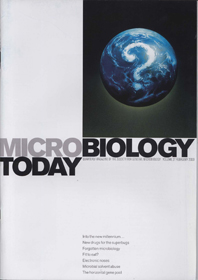The future of microbiology
01 February 2000 publication
The lead articles of the February 2000 issue of Microbiology Today are on microbiology into the new millennium; new drugs for the superbugs; forgotten microbiology; food scares; electronic noses; microbial solvent abuse; and the horizontal gene pool.
Microbiology into the new millennium (p. 02)
Howard Dalton explains how effective communication of our science to the public and policy-makers is crucial if future research is to be funded properly.
New drugs for the superbugs (p. 04)
As we enter the new millennium many of our existing antibacterial agents are under threat from the widespread emergence of bacterial resistance. Ian Chopra describes how the antibiotics of the future will be developed.
Meeting preview: Fighting infection in the 21st century (p. 07)
A preview of the topics to be discussed in the Main Symposium at the joint SGM/SfAM Millennium Meeting at the University of Warwick.
Forgotten microbiology – back to the future (p. 08)
Microbiologists striving to solve problems in the 21st century could well find some answers in the publications of their predecessors, suggests Milton Wainwright.
Fit to eat? Food scares and safe food production (p. 10)
The level of food-borne infections is unacceptably high. Tom Humphrey, Karen Mattick and Frieda Jørgensen question what strategies are being developed to combat this situation, and also ask what current research is revealing.
Not to be sniffed at (p. 14)
Tim Gibson, John Hulbert, Olivia Prosser and Alex Pavlou describe the development of electronic noses for rapid, sensitive detection and diagnosis of microbial infections.
Microbial solvent abuse – a legally encouraged practice! (p. 18)
Scientists are increasingly exploiting the ability of microbes to clean up environmental pollution. Ajay Sharman and Cliff Burton describe the development of a novel bioremediation system to treat waste solvent in the footwear industry.
Some threats and opportunities for learned societies in the new millennium (p. 22)
Microbiologists will always be needed, but what lies ahead for the professional bodies that represent them? Ron Fraser discusses this.
Trawling the horizontal gene pool (p. 24)
Mobile genetic elements fuel bacterial response to environmental stress. Christopher Thomas and Kornelia Smalla discuss how coordinated action is needed to define their importance in biosafety issues as well as to tap their potential as sources of new properties for biotechnology.
Report from the year 2025 meeting of the American Microbiology Society: Discovery of the bacterial 'taxonomy gene' (p. 28)
Howard Gest writes a satirical piece based on his view that the evolutionary history of bacteria was more complex than commonly supposed and cannot be traced with accuracy using 16S rRNA sequences as the sole criterion.
Benchmarking the microbiologist – a new dawn for learning and teaching in life sciences? (p. 31)
Academic standards are under scrutiny by the Quality Assurance Agency. Helen O'Sullivan explains the implications of benchmarking for microbiology teaching in higher education.

